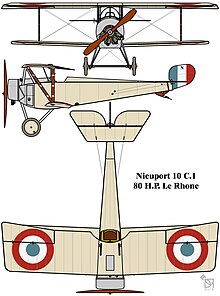Nieuport 10
| Nieuport 10 | |
|---|---|
 French Nieuport 10 (post-colored) |
|
| Type: | Fighter plane |
| Design country: | |
| Manufacturer: | |
| First flight: |
1914 |
The Nieuport 10 was a two-seat French biplane in the First World War of 1914. It was used as a fighter , reconnaissance and training aircraft.
development
In January 1914, Gustave Delage went to the aircraft manufacturer Nieuport and began designing a whole series of aircraft that would make Nieuport very popular. The first machine was the Nieuport 10 , a small two-seater with V-handles between the wings. The lower wings were offset backwards and narrower. The concept envisaged a stable double-decker with good all-round visibility.
The machines were paid for a two-seater with a 80 hp (59 kW) but Gnome-Rhone - rotary engine slightly underpowered. The first types were therefore used as reconnaissance aircraft. Later it was decided to convert a number of machines to single-seaters and to equip the machine with 7.7 mm Lewis MG on the upper wing.
With the successor models Nieuport 11 and Nieuport 12 , the Nieuport 10 was withdrawn from the front and mainly used as a training aircraft. The slightly larger Nieuport 12 was still similar to the machine and had a more powerful 110-hp Clerget radial engine, while the Nieuport 11 was a slimmed-down version that proved to be a very fast and agile fighter.
The types Nieuport 10 and 12 were built in around 170 copies.
Countries of operation
Technical specifications
| Parameter | Data |
|---|---|
| crew | a pilot |
| length | 7.05 m |
| span | 7.92 m |
| height | 2.69 m |
| Wing area | 18 m² |
| Empty mass | 410 kg |
| Takeoff mass | 658 kg |
| drive | a Gnome Rhône rotary radial engine with 80 HP (59 kW) |
| Top speed | 115 km / h |
| Service ceiling | 4570 m |
| Flight duration | 2:30 h |
| Armament | a Lewis MG 7.7 mm |
